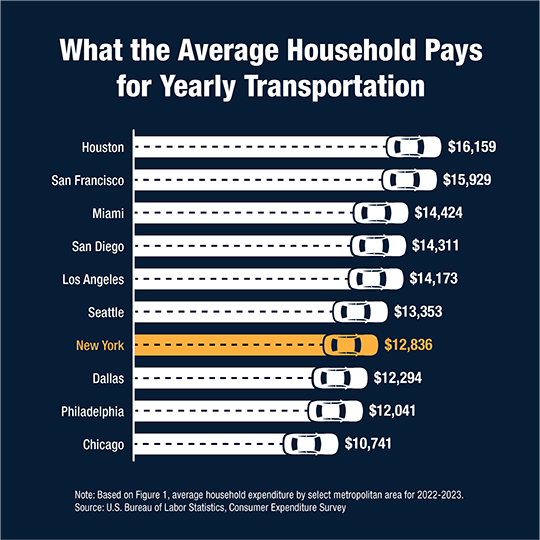Transportation costs for households in the New York City metropolitan area grew by about 56% between 2012-13 and 2022-23, less than in the Los Angeles, Miami and San Francisco metropolitan areas according to a report released today by State Comptroller Thomas P. DiNapoli. Transportation made up the second largest cost for New Yorkers, behind housing, at 14% of household spending.
“Many New Yorkers struggle to make ends meet. While transportation costs in the New York City metro area grew at a slower pace than in other major metro areas, it remains a substantial expense for many New Yorkers,” DiNapoli said. “City residents are fortunate to have a public transit system that operates around the clock to help keep some costs relatively low. City and state officials need to keep a close eye on transportation costs to ensure they remain affordable and help to offset higher costs of other household essentials.”
Share of Household Spending
Transportation costs — which include vehicle purchases, leases, maintenance, gasoline, insurance, and a range of other public and non-public transportation services — comprised the second largest category of household spending nationally in 2022-23 at 17%. The New York City metro area’s lower transportation share compared to the nation’s reflects a significantly higher utilization of public transit.
Transportation Type
In 2023, 48% of New York City households relied on public transportation for work, compared to less than 4% nationally.
Less than half of city households (43.8%) owned at least one vehicle in 2023 while nationally it was 91.6%. Within the city, only about 21% of Manhattan households owned at least one vehicle. On Staten Island, however, 82.6% of households owned a vehicle, followed by Queens at 61.4%, with sections of each of these boroughs having limited public transportation options. According to the American Public Transportation Association, 93% of the average household’s spending on transportation nationally goes toward purchasing or leasing vehicles, gas, insurance and maintenance.
Among city households without any vehicles, more than half used public transportation to commute while about 15% worked from home and another 12% walked, cutting their transportation costs.
DiNapoli’s report found that since 2013, the type of transportation used has changed, contributing to the transportation cost changes in the city. The share of households that used public transportation for work declined in every borough from 2013 to 2023, with Brooklyn seeing a 10 point drop from 52%. At the same time, the share that used taxicabs and car services, motorcycles, or bicycles rose in every borough except Manhattan.
Public Transit
The Metropolitan Transportation Authority (MTA), which operates 24 hours a day, seven days a week, is North America's largest transportation network, serving a population of 15.3 million people in the city and surrounding areas.
Public transportation costs made up the third largest portion of overall transportation costs at nearly 19%. While the average household’s public transportation costs in the New York City metropolitan area fell during the pandemic, partly driven by changes in commuting patterns, costs are about 105% higher than in 2012-2013.
The MTA anticipates a fare increase in 2025 as ridership continues to recover to pre-pandemic levels, with another assumed in the MTA budget in 2027 as it returns to biennial increases of 4%. This will likely impact lower-income households in New York City more, although the city expanded the Fair Fares program recently to discount the cost of transit for more low-income households. In 2022, nearly 48% of households earning less than $51,000 in the city relied on public transportation compared to less than 38% for all other households.
DiNapoli highlighted the importance of continuing to monitor mobility trends, the expansion of the Fair Fares program providing low-cost MTA service for qualified residents, the introduction of year-round full week student MetroCards, and the costs of living associated with vehicle dependence in transit deserts, to inform future policy choices.
Report
The Cost of Living in New York City: Transportation
Related Reports
The Cost of Living in New York City: Housing

